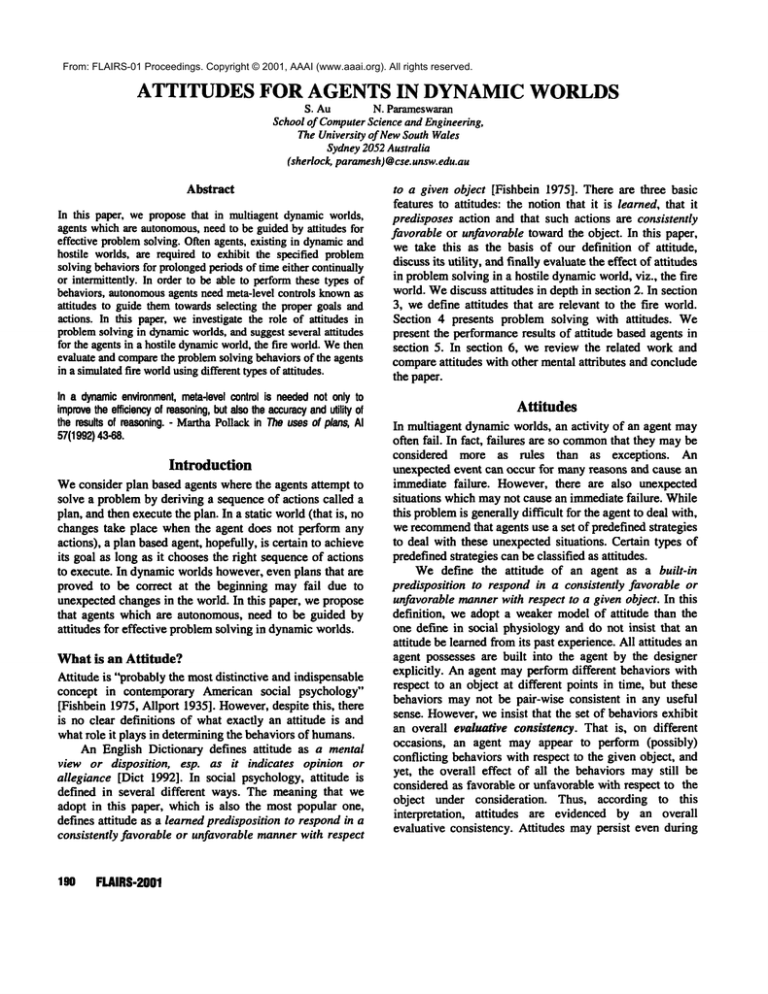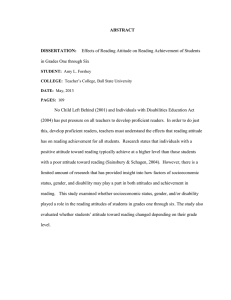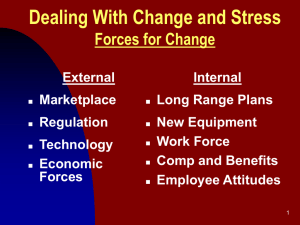
From: FLAIRS-01 Proceedings. Copyright © 2001, AAAI (www.aaai.org). All rights reserved.
ATTITUDES FOR AGENTS IN DYNAMIC WORLDS
S. Au
N. Parameswaran
School of ComputerScience and Engineering,
The University of NewSouthWales
Sydney2052Australia
(sherlock, paramesh)@cse.unsw.edu.au
Abstract
In this paper, we propose that in multiagent dynamicworlds,
agents whichare autonomous,
need to be guidedby attitudes for
effective problemsolving. Oftenagents, existing in dynamicand
hostile worlds, are required to exhibit the specified problem
solvingbehaviorsfor prolongedperiods of timeeither continually
or intermittently. In order to be able to performthese types of
behaviors, autonomous
agents needmeta-level controls knownas
attitudes to guide themtowards selecting the proper goals and
actions. In this paper, weinvestigate the role of attitudes in
problemsolving in dynamicworlds,and suggest several attitudes
for the agents in a hostile dynamicworld,the fire world.Wethen
evaluate and comparethe problemsolving behaviorsof the agents
in a simulatedfire worldusingdifferent typesof attitudes.
In a dynamic
environment,
meta-level
controlis needed
notonlyto
improve
theefficiency
of reasoning,
butalsotheaccuracy
andutility of
the resultsof reasoning.
- Martha
Pollackin Theusesof plans,AI
57(1992)
43-68.
Introduction
Weconsider plan based agents where the agents attempt to
solve a problem by deriving a sequence of actions called a
plan, and then execute the plan. In a static world(that is, no
changes take place when the agent does not perform any
actions), a plan based agent, hopefully, is certain to achieve
its goal as long as it chooses the right sequence of actions
to execute. In dynamicworlds however,even plans that are
proved to be correct at the beginning may fail due to
unexpected changes in the world. In this paper, we propose
that agents which are autonomous, need to be guided by
attitudes for effective problemsolving in dynamicworlds.
Whatis an Attitude?
Attitude is "probably the most distinctive and indispensable
concept in contemporary American social psychology"
[Fishbein 1975, Allport 1935]. However,despite this, there
is no clear definitions of what exactly an attitude is and
what role it plays in determining the behaviors of humans.
An English Dictionary defines attitude as a mental
view or disposition, esp. as it indicates opinion or
allegiance [Diet 1992]. In social psychology, attitude is
defined in several different ways. The meaning that we
adopt in this paper, which is also the most popular one,
defines attitude as a learned predisposition to respondin a
consistently favorable or unfavorable mannerwith respect
190
FLAIRS-2001
to a given object [Fishbein 1975]. There are three basic
features to attitudes: the notion that it is learned, that it
predisposes action and that such actions are consistently
favorable or unfavorable toward the object. In this paper,
we take this as the basis of our definition of attitude,
discuss its utility, and finally evaluatethe effect of attitudes
in problemsolving in a hostile dynamicworld, viz., the fire
world. Wediscuss attitudes in depth in section 2. In section
3, we define attitudes that are relevant to the fire world.
Section 4 presents problem solving with attitudes. We
present the performanceresults of attitude based agents in
section 5. In section 6, we review the related work and
compareattitudes with other mental attributes and conclude
the paper.
Attitudes
In multiagent dynamicworlds, an activity of an agent may
often fail. In fact, failures are so common
that they maybe
considered more as rules than as exceptions.
An
unexpected event can occur for manyreasons and cause an
immediate failure. However, there are also unexpected
situations which maynot cause an immediatefailure. While
this problemis generally difficult for the agent to deal with,
we recommend
that agents use a set of predefined strategies
to deal with these unexpected situations. Certain types of
predefinedstrategies can be classified as attitudes.
Wedefine the attitude of an agent as a built-in
predisposition to respond in a consistently favorable or
unfavorable mannerwith respect to a given object. In this
definition, we adopt a weaker model of attitude than the
one define in social physiology and do not insist that an
attitude be learned from its past experience.All attitudes an
agent possesses are built into the agent by the designer
explicitly. An agent mayperform different behaviors with
respect to an object at different points in time, but these
behaviors may not be pair-wise consistent in any useful
sense. However,we insist that the set of behaviors exhibit
an overall evaluative consistency. That is, on different
occasions, an agent may appear to perform (possibly)
conflicting behaviors with respect to the given object, and
yet, the overall effect of all the behaviors maystill be
considered as favorable or unfavorable with respect to the
object under consideration. Thus, according to this
interpretation,
attitudes are evidenced by an overall
evaluative consistency. Attitudes maypersist even during
periods of behavioral quiescence and are thus generally
more persistent
and more inclusive than motives.
Therefore, the predisposition refers neither to a particular
behavior nor to a class of behaviors, but rather to the
overall favorability of a behavioral pattern. Consequently,
possessing a partial knowledgeof an agent’s attitude does
not necessarily permit prediction of any behavior on its
part.
In AI, the term attitude has so far been used to denote
concepts such as plans [Pollack 1990], beliefs, goals,
intentions, commitments, etc [Rao and Georgeff 1991].
However, we use the term attitude as used in social
psychology where an attitude controls the overall mental,
physical and communicative behavior of an agent towards
an object with the ultimate purpose of either favoring it or
disfavoring it (bidirectional evaluation). Whenthe object
involved is a mental object such as a plan, intention, or
commitment, holding an attitude towards it typically
requires meta-level reasoning. Attitudes have several
characteristics, and we briefly discuss thembelow.
Persistence and Change
Since one primary use of attitudes is to guide an agent’s
behavior in "’confusing" situations (thus helping other
coexisting agents to at least partially predict the over all
behavior of this agent), attitudes once adopted, must persist
for a reasonable period of time. This means the agent’s
mental and physical behavior should be such that any other
"’distractions" the agent might encounter should be either
ignored or postponed, while holding onto the current
attitude. The set of intentions and commitmentsthat are
generated as a result of holding onto the attitude should
also include the persistence requirements of the attitude.
The extent to whichthe agent should strive towards holding
onto a given attitude in dynamicworlds is included in the
behavioral specifications of the attitude. Complexagents,
before changing onto new attitudes, maysometimeschoose
to vary the degree of the currently held attitudes
according to new environmentalconditions (refer to section
3).
Attitudes and Behavior
Whenan attitude is adopted, the agent has to exhibit a
behavior considered appropriate for that attitude. There are
several requirements to this behavior. Firstly, in a dynamic
multiagent world, this behavior must include responses to
all situations including unexpectedstate changes, failures
of current activities, and changes in other agents’ mental
and physical behaviors. Secondly, the sub-behaviors of a
given behavior must have an overall consistency over the
period of time during which the agent is holding that
attitude.
Abstract Attitudes
The notion of overall consistency in an agent’s attitude
based behavior suggests that several attitudes towards a
goal will direct the agent to performbehaviorsthat are nonconflicting and have effects that are consistently favorable
or non-favorable to the goal. This concept indicates that
several attitudes can be grouped together and leads
naturally to the notion of abstract attitude. Twotypes of
abstractions are possible; abstractions over time intervals
and abstractions over physical objects and agents. Let K be
an attitude towardsan object x, denotedK(x). Let xl ..... x, be
the componentsof x. The attitude K consists of two parts:
Ki(xl),...,Kn(x~) whereKi’s are (sub)attitudes; and attitude
K’ is the attitude towards the organizational structure of x.
The sub-attitudes
Ki’s produce the necessary subbehaviors; and the behavior specified by K’ takes into
accountof the fact that the object is composed
of xl ..... Xn..
The organizational structure of x typically uses Allen’s
temporal relations [Allen 1984] for objects such as plans
and the spatial relations for physical objects (walls, doors,
etc).
Meta Attitudes
Whenthe object x happensto be an attitude, the attitude K
towards x becomesa meta-attitude. Meta-attitudes can be
used by the agents to generate more controlled behaviors in
response to changes in the world. Meta-attitudes are
particularly useful during joint activities amongstmultiple
agents. For example, whenan agent Al promises that it is
committingto a plan p, then it is advisable that the agent A2
attach an attitude
value to this promise such as
confutentA2(promiseAl(p)) which means A2 is confutent that
A! will keep its promise towards p. Attitudes in general,
and meta-attitudes in particular, are thus invaluable in
multiagent dynamic worlds. The number of levels metaattitudes can be nested will ultimately depend on the
domain of applications. For example, certain forms of
beliefs are in fact viewedas attitudes. Thus, beliefs about
beliefs, beliefs about beliefs about beliefs, etc. can all be
viewed as meta-attitudes.
In a joint activity, it is
recommendedthat agents hold mutual beliefs [Levesque
1990]. Mutual beliefs demandinfinitely nesting metaattitudes. The depth of the nesting will not only dependon
the application domain, but also on the agent’s ability to
reason about the depth of nesting.
In addition, during problem solving, it may become
necessary for agents to hold morethan one attitude towards
an object at the same time. Someattitudes mayhave to be
held intermittently; that is, the agent mayhold the attitude
for an interval T I, drop it at the end of T 1, pick it up later
for somemore time T2, and so on. Thus, the total duration
for whichthe attitude is held is the sumT of TI and T2, but
the attitude itself is not held continuously.
INTELLIGENT
AGENTS 191
Fire World Attitudes
A fire world is dynamic,typically multiagent, and hostile to
the agents. An agent has to respond to the events in the
world both reactively and deliberately.
Depending on
reactivity alone the agent may not be able to solve its
problems in the fire world. An important feature of
deliberative behavior in a domainlike the fire world is that
an agent mayhave to suppress its reactivity as part of its
deliberative actions. In such situations, agents can use
attitudes to guide their deliberative actions to achieve
appropriate behaviors. Attitudes that are useful in a fire
world maybe classified into several categories, of which
the following are some of the important ones: attitudes
towards the objects in the world, attitudes towards
processes and attitudes towards mental objects.
World Attitudes
An attitude towards a physical object x in the world have
the following attributes (see examplebelow).
ExampleThe following describes an attitude of the agent
towards an object calledfirel.
¯
Nameof the attitude: SmallFire.
¯
Description of object: name:firel; description: fire
on chairl and fire on tablel.
¯
Evaluation:fire is small (multidirectional);
¯
Basic agent behavior towards the objectfirel: attempt
to put out firel, and warnother agents.
¯
Persistence of the attitude: if firel becomesa medium
fire, but the actions in the immediatefuture segmentof
the plan includes putting out part of this fire, then the
fire will still be consideredas small; otherwise, the fire
is considered mediumor large, in which case this
attitude is dropped.
¯
Multiple attitudes: whenthe fire is closer to chemicals,
hold on to the attitude SmallFire, but also adopt
another attitude dangerous (that is, fire is still
considered small but also dangerous);
¯
Type: intermittent.
Attitudes towards mental objects requires similarly several
attributes. For brevity, we only give the attributes for plan
execution as an example, because in our implementation,
plan execution is the most dominantactivity that an agent
performs.
Plan Execution Attitudes
Let p be a plan that the agent wants to execute to reach a
destination.
This plan can be executed with several
attitudes. For example, it may be necessary to execute
without interrupting, and someover several attempts, etc.
Manyinteresting attitudes are possible: escape-exec(p),
normal-exec(p), urgent-exec(p), and execute-quickly(p).
In multiagent cases, cooperation, coordination, team,
group, and so on can be all viewedas joint attitudes.
192
FLAIRS-2001
Problem
Solving
In our model, we have used four fundamental concepts to
generate the desirable behaviors of the agents: beliefs,
attitude, intentions, and commitments.An agent’s attitude
towards an object is based on the beliefs the agent holds
about that object. Attitudes generate appropriate intentions
which result in commitments and ultimately action
execution. An attitude does not predispose an agent to
performany specific behavior, but rather it leads to a set of
intentions that indicate a certain amountof effects toward
the object in question. Eachof these intentions is related to
a specific behavior, and thus the overall effect of an agent’s
actions on the object correspondsto the attitude towardthe
object. Once established, an attitude may influence the
formation of newbeliefs.
Agent Architecture
The agent architecture of our agent has three important
modules: a goal generator, a plan structure module(called
the Time Line Structure - TLS), and an executor. The goal
generator generates goals in response to changes in the
world and the messagesreceived. The goals are then placed
on the TLS, where the executor will plan for the goal and
execute the plan. The strategy used in planning and
execution will dependon the attitude the agent is holding
towards the goal and the derived plan.
Modeling Attitudes
The goal generator generates four types of goals: physical
(states of physical objects), communicative, mental and
behavioral. Physical goals are goals for physical action
such as moving and communicative goals are goals to
communicate to others such as screaming. Mental goals
specify the internal states (states of TLS in our
implementation) to be achieved such as abandoning another
goal while behavioral goals specify the behavior to be
performedsuch as escape. Goals of the first three types are
achieved by planning and executing the plans. Behavioral
goals are achieved by executing the predefined rule bases.
Anagent can have attitudes towards any object specified in
the TLS: goals, plans, actions, and rules (specifying
behaviors). Wemodel attitudes by sets of rules which
generate goals of one of the four types. In the experiments
reported in the next section, we only consider attitudes
towards physical goals and mental goals. The plans are
placed on the TLSaccording to some (appropriate for the
chosen attitude) temporal relations (one of the thirteen
temporal relations discussed in [Allen 1990]).
Performance
Weevaluated the performance of the agents that have
attitudes built into themin a simulated fire world. The fire
world is a large research campuswith several buildings and
rooms, containing many objects such as chairs and
chemicals. Fire is arbitrarily set and let propagate, and the
behavior of the agents were studied over several simulation
cycles. Several experiments were performed and the results
are summarizedbelow.
Experiment 1: Attitudes
In this experiment, the performance of an agent with
different attitudes was studied. The task of the agent was to
save property as fire breaks out in multiple places in a
room. Weconsider three types of attitudes: quickly,
leisurely, and opportunistic. In the quickly attitude, the
agent attends to the newly generated goal immediatelyafter
finishing the current goal. In the leisurely attitude, the
agent attends to the newgoal after completingall the goals
scheduled on its TLS. The third attitude opportunistic
refers to the behavior where the agent sometimesuses the
quickly attitude and sometimesthe leisurely attitude as the
agent thinks is appropriate. Plans were represented
progressively abstractly [Au and Parameswaran1998], and
attitudes were used to modifythe plan structure in response
to world changes.
Fig. I showthat it is beneficial to have somekind of
attitude rather than having no attitudes at all. It is because
attitudes provides the agent with the powerof meta level
reasoning. The performance of the attitudeless
agent
declines rapidly as the rate of change (of the world)
increases, reaching its minimumvery quickly (1"=-8) where
it stabilizes. Agents which had adopted attitudes had a
larger range of effective operation and showedresistance
and tolerance to changes with their performance declining
slowly.
quick
, opportunistic
¯ leisurely,
basic ]
I
E 80
60
40
rapid the world changes were, the agents were able to save
the first object that caught fire. (Weignored situations
whenfire occurred and disappeared so fast that the agents
werenot able to respondto it.)
Experiment 2: Persistence of Attitudes
In Experiment 1, the agent did not make any "’conscious"
effort to hold on to its attitude. As the world changes,
agents mayneed to respond to the changes by dropping one
attitude and adopting another. In this experiment, we
evaluate the performance of an agent that holds on to its
chosenattitude longer than it was expected to, despite the
harmful situations the agent encounters in the world.
Holdinga particular attitude longer than it was meant
to might affect the very survival of the agent. For example,
some of the reactive behaviors maybe affected when the
agent persists too strongly on a chosenattitude, leading to
the detriment of its health. Fig 2 shows an interesting
behavior exhibited by the agent in the fire world. It shows
the effect of sacrificing the agent’s health in order to
achieve a given goal. Operational range (OR) at a given
rate refers to the measure of "freedom" the agent has
towards achieving a given goal sacrificing its health but
without dying. At the lower rate, the operational range is
narrow since to trade off health to achieve its goal, the
world itself did not offer muchopportunity to risk one’s
health. Similarly, at higher rates, the range once again is
too narrow, since opportunity is less as the world changes
too fast. For intermediate values, however,the agent finds
moreopportunity to risk its health for the sake of achieving
the goal. Thus, we find that, at a given rate of changewhile
the risk taking agents have greater possibilities
of
achieving a given goal and still manageto survive in the
world, highly health conscious agents face the risk of not
being able to solve the given problem but also the face of
risk of being trapped in the world often leading to death
ultimately.
m
20
5
|
0
2
i
|
g
w
!
|
w
|
4
6 8 10 12 14 16 18
rate of change
Fig 1. Achievementvs rate of change
Amongthe three attitudes,
the attitude quickly
performs better than the attitude leisurely because, in the
quickly attitude, the fire was controlled during its initial
phase before it becameunmanageable. Overall, Ao was the
best of the three as it used a meta-attitude taking advantage
of both attitudes urgently and leisurely. Notice that even
though all agents performed poorly when the world
changedvery quickly, the agents were still able achieve a
non-zero success rate. This was because no matter how
e~
o
0
0
2
4
6
rate of change
Fig. 2. Operational range Vsrate.
Experiment3: Meta-attitudes
The final experiment investigates the use of meta-attitudes
in problem solving. Clearly, we would prefer an agent that
minimizes on its health penalty and but still managesto
solve its goal. In this experiment, we introduce an agent
which is capable of adopting meta attitudes. Metaattitudes
control the degree of base level attitudes by varying their
INTELLIGENT
AGENTS 193
strength. Meta attitudes were implemented using a (meta
level) goal generator which generated meta level goals
specifying the level of commitmentthe agent had to have
towards its adopted base level attitudes. Fig. 3 showsthat
this agent is more tolerant to world changes than the one
which did not have this attitude. The dotted lines represent
performance of agents holding base level attitudes only,
while the solid line depicts the positive effects of the meta
attitude.
25
cautious
20
’~ 15
~,
10
"
immediate
¯ ~ 50
0
|
m
0
2
4
6
8
rate of change
Fig. 3 Meta Attitude Vs. Base Level Attitudes.
Several other experiments were also conducted where
attitudes were used to control the behavior of the agents to
achieve coordination amongst multiple agents, and in
problem solving that spread over prolonged periods of
time. To summarizethe results, whenagents did not have
attitudes, they performedpoorly (and in fact died too early
as the fire spread in manycases). Attitudes gave the agents
the necessary mental behaviors which helped them
manipulate their internal states in response to changes in
the world so that agents could not only achieve their goals,
but also exhibited acceptable behaviors during the course of
problem solving (such as choosing to stay too close to
large fires, walk over fire, etc. when no other options
existedto saveits life).
Related Workand Conclusion
In AI, the term attitude has been used to denote different
concepts. For example, Pollack[Pollack 90] refers to plans
as mental attitudes. [Kalenka and Jennings 1995] identified
responsibility, helpfulness, and cooperativeness as three
important social attitudes that may prevail in social
problem solving. It is also commonamongthe researchers
to refer to beliefs, goals, and intentions as attitudes. In this
paper, we have viewed attitude towards an object x as a
mechanism which generated an appropriate meta-level
behavior with regard to that object. Wealso argued that
attitudes can be complex as abstract attitudes,
meta
attitudes, and joint attitudes. Intention does not always
say how soon a goal must be achieved, and commitment
does not say howstrong it should be. The role of attitudes
is to specify this extra parameter so that agents can adapt
their behavioursto newsituations.
194
FLAIRS-2001
Georgeff et al. [Oeorgeff et al 1998] report experiments
similar to our Experiment 1 where the agent attempts to
maximize its score using intention as a guide to filter
currently available options. In our case, the behavior is
much more complex where depending on the attitudes
adopted, the agent exhibits different types of mental
behaviors.
In dynamicworlds, agents are not only required to strive
for solving their goals, but are also expectedto exhibit only
acceptable behaviors during the process of problem
solving. Attitudes are necessary to guarantee this behaviour
while at the same time maintaining consistency and
predictability of behaviors across multiple agents when
they are involved in collective problemsolving. Attitudes
guide not only the individual agent’s behaviors, but also the
behaviour of a group of agents. We are currently
investigating application of attitudes to collective problem
solving and the results are reported in [Madhu2001].
References
[Allen 1984] J. Allen. Towardsa General Theory of Action
and Time. AI Magazine, Vol.23 1984. Pp 123-154.
[Au and Parameswaran 1998] Au S., N. Parameswaran,
Progressive Plan Execution in a DynamicWorld, Planning
Workshopin AIPS 1998.
[Diet 1992] The Angus & Robertson Dictionary and
Thesaurus, HarperCollins Publishers Sydney2001, 1992.
[Allport
1935] Allport
G W Attitudes
in C M
Murchison (ed) Handbook of Social Psychology,
Worcester, Mass, Clark Univ Press, 1935.
[Fishbein 1975] Fishbein Mand Ajzen I Belief, Attitude,
Intention, and Behaviour An Introduction to Theory and
Research, Addison-Wesley Publishing Company,1975.
[Kalenka and Jennings 1995] S. Kalenka and N.R.
Jennings: On Social Attitudes: A Preliminary Report,
International Workshopon Decentralized Intelligent and
Multi-Agent Systems, Krakow,Poland, Nov. 22-24, 1995.
[Levesque 1990] Hector Levesque, Jose Nunes and Philip
Cohen. On Acting Together. National Conference on
Artificial Intelligence, 1990.
[Georgeff et al 1998] M. Georgeff, B. Pell, M. Pollack, M.
Tambeand M. Wooldridge. The Belief-Desire-Intention
Model of Agency. In Proceeding of the 5th International
Workshop, ATAL1998.
[Madhu2001] PhDThesis: TeamActivities in Multiagent
World. UNSW2000.
[Pollack 1990] M. E. Pollack, "Plans as ComplexMental
Attitudes," in P. R. Cohen, J. Morgan,and M. E. Pollack,
eds., Intentions in Communication,MITPress, Cambridge,
MA, 1990.
[Rao and Georgeff 1991] A. Rao and M. Georgeff.
Modelingrational agents within a DBI-architecture. KR&R
1991, pp 473-484.








